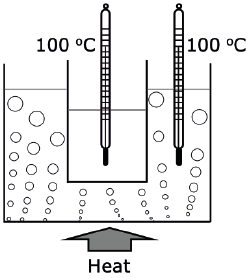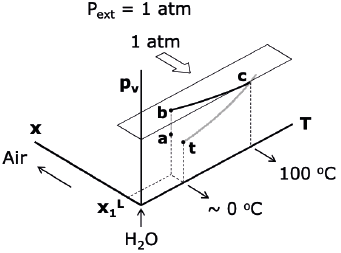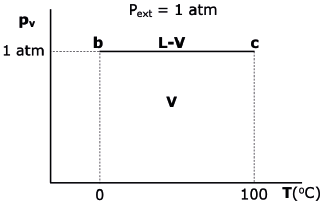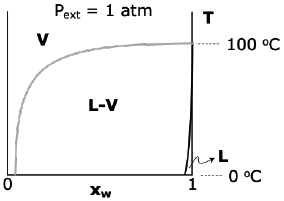Introduction
As it is widely known, when a liquid is heated in an open vessel, it vaporizes exclusively from the free liquid surface until the saturation of the surrounding gas with the evaporating substance. In such a case, when the vapor pressure of a liquid equals the external pressure, there is a condition of free vaporization throughout the liquid. The temperature at which such a condition is reached by a pure substance is called the boiling temperature and is unique for each external pressure. When the external pressure is 1 atm (101.325 kPa) the boiling point is called normal (Silberberg and Amateis, 2018, p. 481; Atkins and de Paula, 2010, p. 138). Thus, the normal boiling point for pure liquid water is 100 °C (373.16 K).
The last statement is in agreement with our common experience in which water only boils when the temperature reaches about 100 °C, if the external pressure is 1 atm or very close to it. However, the water we use every day is not a pure substance. Tap water has dissolved salts (nonvolatile solute) that cause an increase in the boiling point (Silberberg and Amateis, 2018, p. 559), although such effect, which only causes a boiling point bias, may not be easily perceived. On the other hand, common water, but even distilled one, in equilibrium with the surrounding air, becomes a solution since it has dissolved air (volatile solute). This kind of solutions do not have a single boiling point at a given pressure, but the temperature at which it boils is fixed by the composition. Thus, even without changing the pressure, a solution has multiple boiling points and not just one as a pure substance (Atkins and de Paula, 2010, p. 179).
Water in an open vessel at equilibrium is actually a saturated air-in-water solution.
Water dissolves air in a quantity given by Henry's law (Silberberg and Amateis, 2018, p. 551),
Relevant aspects of the air-water system
A deeper analysis of the water-air system is presented below. Considering water-air
in an open vessel as a two-component system (air as an individual component), a P-T
diagram would be a projection of P-T-xL diagram (xL is the
mole fraction of one component at liquid phase). These diagrams are correctly
represented (Andrade-Gamboa, Mártire, and Donati,
2010) by replacing P (= Pext ) by pv (there is a
particular diagram for each Pext): Figure
1 shows a pv-T-xL diagram (for Pext = 1
atm), in the region from pure water
In figure 1, the gray line is the liquid-vapor
curve for pure water, from triple point, t (~0 °C), up to 100 °C. For a dissolution
with
A projection onto plane pv-T of the diagram of figure 1 is shown in figure
2. Such diagram allows concluding-in a redundant but more dramatic
way-that for all temperatures (from point b to point c) total vapor pressure equals
external pressure. As was suggested above, from 0 °C to 100 °C, saturated solutions
of air in water in an open vessel are under boiling condition. In
order to describe the system behavior, it is very useful to construct the projection
of figure 1 on the T-x plane. Table 1 shows the values
Table 1 Vapor (V) and liquid (L) composition for dissolutions of air in water at different temperatures (xw: water mole fraction).
| T (°C) |
|
|
T (°C) |
|
|
|---|---|---|---|---|---|
| 0 | 0.006021 | 0.999977 | 55 | 0.155448 | 0.999991 |
| 5 | 0.008587 | 0.999979 | 60 | 0.196704 | 0.999992 |
| 10 | 0.012140 | 0.999982 | 65 | 0.246940 | 0.999992 |
| 15 | 0.016877 | 0.999984 | 70 | 0.307738 | 0.999993 |
| 20 | 0.023095 | 0.999985 | 75 | 0.380576 | 0.999994 |
| 25 | 0.031287 | 0.999986 | 80 | 0.467529 | 0.999995 |
| 30 | 0.041946 | 0.999987 | 85 | 0.570667 | 0.999996 |
| 35 | 0.055567 | 0.999988 | 90 | 0.692065 | 0.999997 |
| 40 | 0.072839 | 0.999989 | 95 | 0.834287 | 0.999998 |
| 45 | 0.094651 | 0.999990 | 100 | 1 | 1 |
| 50 | 0.121792 | 0.999990 |
For calculations see Appendix 1
In figure 3, the black line, as mentioned, represents the solubility of air in water as a function of temperature (curve bc in figure 1), and corresponds to the liquidus line (the boiling point curve), and the gray curve gives the vapor composition (vaporus line).
Table 1 and figure 1 show that vapor in equilibrium with a saturated solution of air in water is mainly composed of air at temperatures below 50 °C, decreasing up to 50% at 80 °C. Then, the air content rapidly decreases with increasing temperature until 100 °C when vapor is pure water.
Is there boiling at the boiling point?
The arguments developed above may have convinced the reader that saturated air-in-water solutions, in an open container, are at the boiling temperature if the fixed external pressure is maintained. However, from our everyday experience, can we say that water boils at all temperatures?
Before starting a discussion about that point (the central one for this paper), we must resolve a semantic and conceptual question in a more general sense. What is the meaning of boiling and boiling temperature? Neither term is defined by IUPAC (2019), and their widespread use is not without ambiguity, since boiling is considered as either a process or a condition. Some expressions that exemplify each criterion are: "A liquid boils when it forms bubbles against the atmospheric pressure" (Silberberg and Amateis, 2018, p. 410) "When the vapour pressure is equal to the external pressure, vaporization can occur throughout the bulk of the liquid and the vapour can expand freely into the surroundings. The condition of free vaporization throughout the liquid is called boiling" (Atkins and de Paula, 2010, p. 138). For the first definition, a liquid at the boiling temperature can form bubbles, and for the second definition it must form bubbles (boiling is equal to bubbling, discarding bubbles formed by external causes). The title of this section could be changed to: Is there bubbling at the boiling point? The best answer should be: there may or may not be. Then, air-saturated water, in an open system at constant pressure, is at boiling temperature at all temperatures, and at those temperatures it can boil.
The boiling process for a pure liquid
It can be curious and even contradictory that a liquid at its boiling temperature may not boil or cannot boil. Considering the boiling point as the temperature at which the vapor pressure of a liquid equals the external pressure surrounding the liquid is very accurate, and its thermodynamic nature does not give rise to doubts. Is this requirement sufficient to guarantee the boiling of the liquid? Or even more, should the boiling happen at one fixed temperature?
Some boiling temperature definitions try to make the thermodynamic vision and the occurrence of the boiling process compatible. They define boiling point as the temperature at which the vapor pressure inside bubbles in the liquid equals the external pressure (Silberberg and Amateis, 2018, p. 481) or the external pressure plus hydrostatic pressure of the liquid (Chang, 2010, p. 493). However, the equality of pressures requires thermodynamic equilibrium, while the bubbles are not usually in thermal equilibrium with the surrounding liquid. A bubble may exist if the difference in pressure inside and outside it is enough to generate and keep its place inside the liquid. The vapor phase is confined inside the bubble due to the surface tension at the liquid-gas interface because of the net attraction force on molecules towards the liquid. Even ignoring the pressure due to the depth of a bubble below the free surface of the liquid, the pressure inside (vapor pressure) must be higher than the pressure outside (external pressure that is the atmospheric pressure in an open vessel).
That is why the boiling process (associated with the existence of bubbles rising to the top) does not occur (or, at least, it does not necessarily take place) under the conditions the thermodynamic definition implies. A proof of that can be obtained through a simple experiment, as is indicated in figure 4.

Figure 4 Internal vessel and external container filled with water. After enough heating and even when the temperature in both thermometers reaches the same value (boiling temperature), bubbles are only detected in the external container.
The internal vessel and the external container are filled with water, and the latter is heated to its "boiling point" (if the external pressure is 1 atm, it means 100 °C) characterized by the presence of bubbles; however, no bubbles are detected inside the internal vessel although its temperature also reaches 100 °C. Strictly speaking, it is very likely that the temperature in the external vessel is not exactly 100 °C even if the external pressure is 1 atm. There are many circumstances that may justify its variation, and here we will avoid entering into a detailed discussion, which was already raised from a historical and epistemic point of view (Chang, 2004). In any case, such experiment, among others, seems to be enough to show that even pure water (accepting that close to 100 °C, dissolved air is not present) at the boiling point is not necessarily boiling, i.e., matching pressures are necessary but not sufficient for the occurrence of boiling.
Actually, to reach the sufficient condition of boiling, a nonequilibrium condition must be imposed (Levine, 2009, p. 222). To obtain sufficient vapor pressure to form a bubble, superheating is necessary. But even uniform superheating could not cause such process; for example, very pure water can be uniformly heated as in a microwave oven (Erné and Snetsinger, 2000) even up to 300 °C (Hewitt, 1998), remaining in a metastable state of superheating without boiling.
Superheating needed for bubble formation (Çengel and Ghajar, 2015; Collier and Thome, 1994) can be easily reached when a liquid is heated over a hot plate. In this case, the temperature of the liquid close to the hot place reaches higher values than in the rest of the liquid (as for the water near the base of the external container and not for the water in the internal container, as is schematized in figure 4). In this condition, the vapor pressure is higher enough, and bubbles can be formed at the bottom of the vessel, close to the hot surface. Although bubbles can exist in such a way, it does not guarantee they can rise to the top, i.e., it is not enough for boiling. Bubbles hotter than the liquid collapse since heat would flow into the liquid causing partial vapor condensation. When the temperature of the liquid is below the thermodynamic boiling temperature (at the given external pressure) any bubble rising to the top immediately disappears; under this condition bubbles are restricted to a zone close to the hot surface, and the process is called subcooled boiling (Çengel and Ghajar, 2015).
To not collapse the bubble must be at an equal or even lower temperature than the surrounding liquid, and that occurs when the bulk liquid has achieved the maximum temperature possible at the external pressure. Heat is transferred to cooler bubbles, which allows them to grow and, due to the buoyancy forces, rise to the top. In this way, a massive and continuous escape of bubbles to the surface is produced, which is identified as the boiling process.
Although the conditions for continuous bubbling exist, a nucleation process is also needed for bubble formation (otherwise, a metastable superheated situation is achieved) and decides its kinetics. Homogeneous nucleation involves vapor formation from bulk liquid helped by a perturbation such a density fluctuation. In contrast, heterogeneous nucleation is promoted by imperfections of a surface, such as the walls of the vessel (which also explains how boiling stones or chips work). This kind of nucleation is much more probable under regular conditions because it requires lower superheating than that needed for homogeneous nucleation.
The boiling process for an air-saturated water
As for pure substances, for solutions reaching boiling much more than the boiling equilibrium condition is needed. According to our proposal and from an equilibrium point of view, air-saturated water in an open vessel at constant external pressure is at its boiling point at any temperature from the freezing point to the boiling temperature of pure water. But daily observation does not seem to show a boiling process occurring at that temperature range, except at the temperature of 100 °C, if the external pressure is 1 atm. For this, the liquid solution should be exposed to superheating (at least only few degrees above the liquid temperature) and in such way bubbles should appear, and the boiling process would occur.
At temperatures below 80 °C, bubbles mainly contain air (Table 1) but in a very small amount in the solution; thus, even under superheating conditions, the nucleation of bubbles and their growth are seriously limited by air diffusion from the bulk liquid to the depleted region. This is why the process could be very slow and probably it could not be noticeable at very low temperatures. A glass with cold tap water allowed to stand at warmer room temperature fits with that description. In that daily situation and after 2 or 3 h, several bubbles about 1 mm in diameter attached to the walls can be observed. This is commonly interpreted as a different phenomenon in which "pure" air bubbles formed from dissolved air, although it is totally compatible with the vision presented here: the solution is boiling and the bubbles are mainly composed of air. Moreover, the explanation proposed in this work avoids the usual misconception in students who consider dissolved air as air even in a gaseous state (very small, then unobservable, bubbles).
Surely the inefficient heat transfer from the external air to the glass, the cooler surrounding liquid, among other reasons, can explain that in such home experiment, the bubbles are on the walls of the glass and rarely detach and rise to the surface as in the case of subcooled boiling. The situation can be clearly enhanced leaving the glass with cold tap over a metal surface heated just few degrees above the liquid temperature.
At temperatures higher than 80 °C, bubbles essentially contain water (which is the major component) and the processes of bubble formation and growth (now controlled by heat transfer) become faster. The rate of bubble growth in water at 100 °C is about three orders of magnitude greater than those of an air-water system at room temperature (see Appendix 2), which fits within the order of the time needed (about an hour) to achieve the formation of bubbles in the daily observation of the glass of cold tap water. Due to these reasons, bubbles are rarely observed in air-saturated water at low temperatures (except in situations similar to that described above and after some hours), which fits with the idea of a boiling point equal (or close) to the boiling point of pure water. However, giving the adequate conditions, air-saturated water in an open vessel can boil at any temperature from the freezing point to the boiling temperature of pure water at the external pressure.
Conclusion
Since the total vapor pressure of air-saturated water in an open vessel is always equal to the external pressure, that system is at the boiling point at any temperature. Similarly, to what happens for pure substances, to achieve boiling (i.e., the process characterized by the formation of vapor bubbles that migrate into the vapor phase), the solution must be superheated just few degrees above that of the rest of the liquid. However, the formation of bubbles (and consequently, the boiling process) that contain almost only air at low temperatures is much slower than for bubbles that contain almost exclusively water, as occurs at temperatures near the boiling point of pure water.
The introduction and discussion of the main arguments developed in this work, and the performance of extremely simple experiments could be an excellent way to discuss concepts related to the changes in the state of solutions (especially of gases in liquids) and to avoid some common misconceptions about these issues.











 nueva página del texto (beta)
nueva página del texto (beta)





